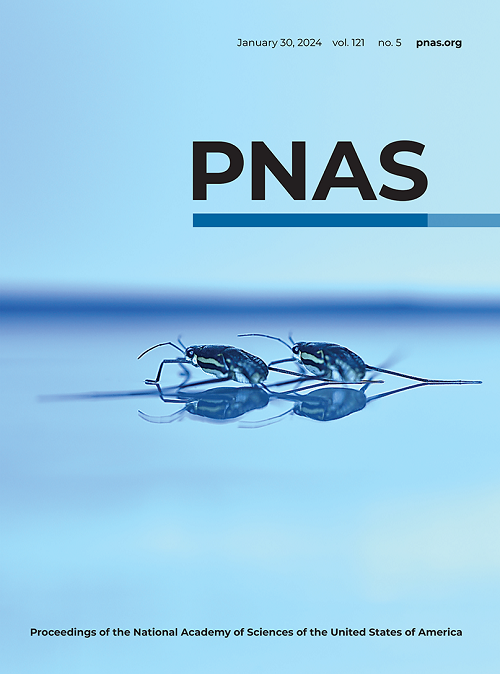脑特异性动力蛋白超家族成员RNF112的结构和功能表征
IF 9.1
1区 综合性期刊
Q1 MULTIDISCIPLINARY SCIENCES
Proceedings of the National Academy of Sciences of the United States of America
Pub Date : 2025-04-08
DOI:10.1073/pnas.2419449122
引用次数: 0
摘要
大鸟苷三磷酸酶(gtpase)的动力蛋白超家族的大多数成员在鸟苷三磷酸(GTP)水解反应中具有重塑膜的能力。Ring Finger Protein 112 (RNF112) (ZNF179/neurolastin)是最近发现的一种脑特异性动力蛋白样蛋白,具有一个非常有趣的新基因(Ring)手指结构域。尽管RNF112在神经元发育中作为E3连接酶发挥着重要作用,但其结构及其GTPase活性的确切作用尚不清楚。在这里,我们确定了截断的RNF112 (RNF112 T)在不同的核苷酸加载状态下含有GTPase结构域(GD)和三螺旋中间结构域(MD)的晶体结构。在无核苷酸(载子)状态下,单体RNF112 T保持独特的自我约束构象,其特征是MD近端与GD中的凹槽对接。在GTP水解的过渡状态下,MD从GD中释放出来并拉伸到一边,形成一个缠绕在一起的RNF112 T二聚体。工程RNF112携带ATL1的c端元件或酵母Sac1p的两个跨膜结构域,重新定位到内质网,能够介导膜重塑。综上所述,我们的研究结果为RNF112作为动力蛋白类大GTPase的细胞功能提供了必要的理解,并为动力蛋白超家族蛋白的功能机制提供了见解。本文章由计算机程序翻译,如有差异,请以英文原文为准。
Structural and functional characterization of the brain-specific dynamin superfamily member RNF112
Most members of the dynamin superfamily of large guanosine triphophatases (GTPases) have an ability to remodel membranes in response to guanosine triphosphate (GTP) hydrolysis. Ring Finger Protein 112 (RNF112) (ZNF179/neurolastin) is a recently identified brain-specific dynamin-like protein possessing a really interesting new gene (RING) finger domain. Despite its essential role as an E3 ligase in neuron development, the architecture of RNF112 and the exact role of its GTPase activity remain unknown. Here, we determined the crystal structure of truncated RNF112 (RNF112 T ) containing a GTPase domain (GD) and three-helical middle domain (MD) at different nucleotide-loading states. In the nucleotide-free (apo) state, the monomeric RNF112 T remained in a unique self-restraint conformation characterized by docking of the proximal end of the MD to a groove in the GD. At the transition state of GTP hydrolysis, the MD was released from the GD and stretched aside to form an intertwined RNF112 T homodimer. Engineered RNF112 equipped with the C-terminal elements of ATL1 or the two transmembrane domains of yeast Sac1p relocated to the endoplasmic reticulum and was capable of mediating membrane remodeling. Taken together, our results offer necessary understandings of RNF112 as a dynamin-like large GTPase in its cellular function and provide insights into the functional mechanisms of dynamin superfamily proteins.
求助全文
通过发布文献求助,成功后即可免费获取论文全文。
去求助
来源期刊
CiteScore
19.00
自引率
0.90%
发文量
3575
审稿时长
2.5 months
期刊介绍:
The Proceedings of the National Academy of Sciences (PNAS), a peer-reviewed journal of the National Academy of Sciences (NAS), serves as an authoritative source for high-impact, original research across the biological, physical, and social sciences. With a global scope, the journal welcomes submissions from researchers worldwide, making it an inclusive platform for advancing scientific knowledge.

 求助内容:
求助内容: 应助结果提醒方式:
应助结果提醒方式:


